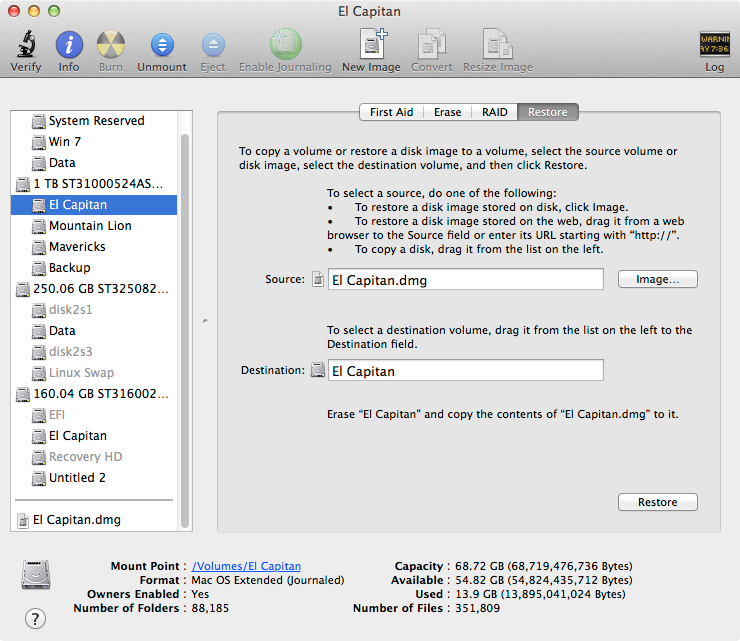

- #Mac os disk utility mbr mac os
- #Mac os disk utility mbr install
- #Mac os disk utility mbr Pc
- #Mac os disk utility mbr mac
So, since 10GB is nothing for data, I decided to put that data somewhere else, delete that partition, and resize the partition for the backups to take over the use of that space.ġst partition 122GB - Time Machine backup (have not done the backup yet)Ģnd partition 30GB - Fresh install of Tiger The larger your drive, the further back you can go in time. They say it is best to have an external drive that is larger than your main drive that you are backing up to with Time Machine, as it is always adding new data. I have since upgraded to Leopard and decided that I would like to use Time Machine instead of SuperDuper backups for now.


I have an external drive that had 3 partitions:ġst partition 111 GB - Bootable copy of my hard drive when I had Tiger cloned with SuperDuperĢnd partition 10 GB - Extra storage for my dataģrd partition 30 GB - Fresh installation of Leopard (Remember that a PPC machine cannot boot from a GTP-partion-scheme drive, hence the need to use APM in this instance seeing as the Partition Scheme applies to the entire drive (it can't be different for each partition.) The only real use for doing this, though, is if you want a multi-partitioned backup drive with separate bootable partitions for OSX-PPC & OSX-Intel machines.
#Mac os disk utility mbr mac
You can, however, clone an Intel-Mac-OSX internal drive that has a GPT partition-scheme (using CarbonCop圜loner or SuperDuper) to an external drive with APM, & the Intel Mac will still be able to boot from that clone. to make your external drive bootable for your Powerbook G4, choose 'Apple Partition Map' in the 'Options' page prior to partitioning.ĪFAIK, an Intel Mac CAN boot from an APM-partitioned drive (this is why the OSX installer can be univerally bootable!), BUT, the problem is that the OSX installer will NOT let you install OSX-intel on an APM-partitioned drive.
#Mac os disk utility mbr Pc
Master Boot Record (to create a bootable PC drive) (note: Power PC's cannot boot from a GPT drive))Īpple Partition Map (to create a bootable drive for a Power PC Mac) To do this, click on the 'Options' button in 'Disc Utility' when on the 'Partition' page before partitioning.
#Mac os disk utility mbr mac os
(please someone correct me if I'm wrong here)įor a Power PC Mac to be able to boot from an external firewire drive, the drive MUST have an APM (Apple Partition Map) Partition Scheme underlying the Mac OS Extended partitions. When re-partitioning a drive in 'Disc Utility', the original partition-scheme sticks, so if you simply re-partition the drive to Mac OS Extended, it will still have an MBR partition scheme. Then this format has an underlying MBR (master boot record) partition-scheme. If your ext hard drive has been FAT32-formatted for PC out of the box. you would need to boot from your Install Disc and run Disc Utility before you could make any partition changes to your internal HD and this would also require you re-install the OS again. I wasn't sure if in your original post you were referencing to an internal drive. Just to clarify, which drive have you resized? Only the 1st Partition of your external HD? The first partition will be kept intact and the second one will be "merged" therefore you will loose all contents (I made sure it was empty before running the merge just in case). Sudo diskutil mergePartitions "Journaled HFS+" New disk1s1 disk1s2ĭid the trick (New is the name, it will actually be ignored). That listed back 2 partitions with the identifiers: disk1s1 and disk1s2 (in other cases might be disk0.) It's still there in some form or another, but is it retrievable, or did Apple give me information that was not correct?Īlso, on another forum, I found the another way of merging partitions that I have not tried yet. The amount of space that is being taken up is the same amount of space that the data was taking up when it was still there. That, however, does not seem to be true, as when I open the resized partition, there is nothing there, yet it says there is only 21.72GB available out of a possible 122.88GB. I was told by Apple that if I used Disk Utility in Leopard to delete one partition and resize another one to take over the amount of space that was gained by deleting the first partition, that no data would be lost.


 0 kommentar(er)
0 kommentar(er)
